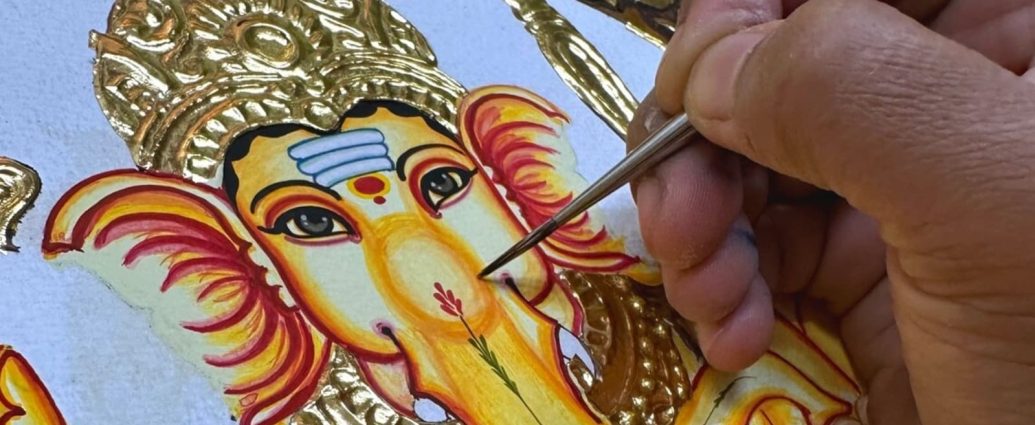Tanjore art is a unique and captivating form of South Indian painting that will leave you in awe. With its shimmering gold foil and intricate designs, this traditional style brings Hindu gods, goddesses, and mythology to life. Originating from the historic town of Thanjavur, each Tanjore painting is a true masterpiece, taking weeks or months to create with a combination of base preparation, gold leaf application, embossing, and pigmented painting. Get ready to dive into the world of Tanjore Art and discover its stunning techniques, materials, and styles.
Talking to HT Lifestyle, Vibha Raj, Tanjore artist and founder of the Tanjore Collective, shared useful insights on Tanjore art including origins, significance, types, material used and all you need to know. (Also read: 6 beautiful traditional Indian artforms you must know about)
1. Origins of Tanjore art
Tanjore paintings, also known as Thanjavur paintings, are a revered form of South Indian art that has a rich and storied history dating back to the 16th century. Originating in the city of Thanjavur in Tamil Nadu, India, these paintings were created during the grand era of the Chola dynasty and the Nayak period, and reached the zenith of their cultural significance during the Maratha period in the 18th century.
2. Distinguishing Features
One of the most distinguishing features of Tanjore art is the gold that’s used in creating these paintings. The gold is usually placed on an embossed part of the canvas which gives these paintings depth in their appearance. They are adorned with precious stones like Kundan stones and Swarovski crystals, which add a touch of elegance and richness to the painting.
3. Significance
While there is a fascination with the very art form of Tanjore paintings, these paintings hold a very special place in most people’s hearts. Being a classical art form, they are treasured for their historical and cultural significance. Tanjore art typically depicts various Hindu gods and goddesses. Hence, they are typically placed in homes, temples, and other religious institutions as a form of decoration and religious devotion. In homes, they are often displayed in living rooms, bedrooms, or puja rooms as a symbol of wealth, culture, and religious faith. In temples, they are displayed as part of the temple’s decor.
In recent years, Tanjore paintings have also become popular among art collectors. The popularity of these paintings has led to a lot of demand for people wanting to learn this intricate art form from all over the world.
4. Materials used
These paintings are created using a range of materials, each carefully selected and combined to create the unique and recognizable style of Tanjore paintings. Over the years, the materials used for these paintings have also evolved depending on availability, access to materials and a number of other reasons.
- Wooden Board – The base of the painting is typically made from a wooden board, which serves as a canvas for the artwork.
- Jesso – A mixture of edible gum, chalk powder and limestone is used for embossing. The embossing is used to add height and depth to the paintings. The jesso is usually applied using a cone or a brush.
- Gold sheets – Gold in the form of sheets or leaves is used to add shine and richness to these paintings. They are typically applied to the embossed part of the canvas. The quality of gold goes up to 24 carats.
- Kundan Stones – Precious and semi-precious gems and stones add depth and texture to the artwork. These gems and stones are carefully selected and arranged to create intricate patterns and designs, which further enhance the beauty and complexity of the painting.
- Paint – Originally, the paint used in Tanjore paintings was made from natural pigments, such as vegetable and mineral dyes. Nowadays, with the evolution of materials and availability, artists use poster paints, which give the paintings their characteristic vibrant and rich colour palette.
5. Process of creating
The amount of time it takes to create a Tanjore painting can vary greatly depending on the size, complexity, and level of detail of the painting. On average, a small to medium-sized painting can take several weeks to complete. A large and intricately detailed painting can take several months to complete. The process of creating a Tanjore painting is time-consuming and requires a great deal of skill and attention to detail.
6. Different types of Tanjore art
Tanjore art varies from the gods and goddesses that they depict to the themes and landscapes used. As with any artform, the techniques and styles have kept evolving and they continue to do so. Most recently, there has been a trend to exaggerate the embossed effect of Tanjore paintings by using plaster of paris or wooden planks, to give these paintings a three-dimensional look. While most people are drawn to Tanjore paintings for its tradition, even this art is not immune to trends and experimentation.
